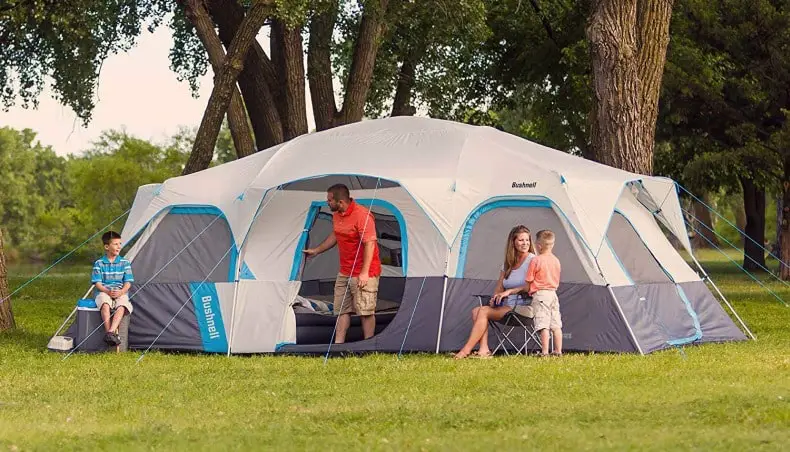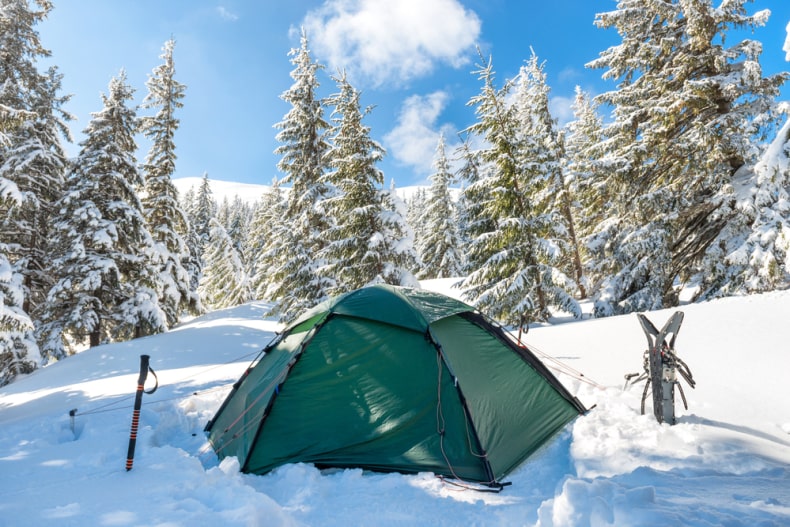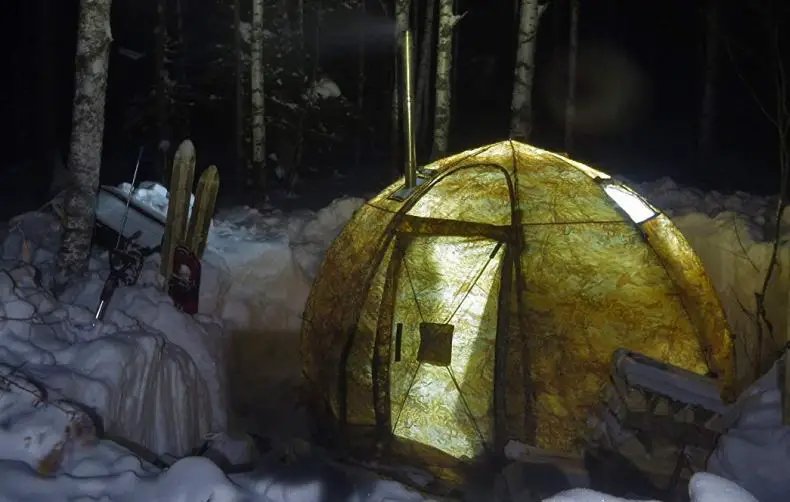When you go camping, one of the most important things to take with you is a tent most of the time. The real struggle is that the weather may not be perfect, so you need to have a tent that can withstand a reasonable amount of water to keep you dry in a storm. However, many may wonder what a good waterproof rating would be for a tent.
If you’re wondering about this, there is a reasonable answer. This comes down to the measurement you’re seeing. You want to look for something between 8,000 to 15,000mm or 300 to 600D. Depending on the type of rating they give you, which is often based on fabric or just what companies choose to display, both of these ratings will work.
Your MM rating simply means millimeters, which is roughly how many millimeters of water a tent can take before it leaks. This is often judged simply by pouring water on the top of a tent to see how much water it can take when water begins to collect. Once it is determined it can reach a specific level without leaking, it is assessed the “MM” waterproof rating.
Denier, on the other hand, is often used to assess the waterproofness of fabric. You’ll more often see this rating used for clothing over tents, yet some places still add it to the label or information sector of a tent too. We’ll get to more on this in just a bit.
It is also important you know the differences between something that is waterproof and water-resistant.
Table of Contents
Waterproof vs Water-Resistant
A lot is made about how a tent was supposed to be waterproof but could not handle a light shower. It is more than likely that a person was told a level of water resistance regarding their tent and NOT a level of waterproofness.
While several newer tents will have some level of waterproof nature, that is not always going to be very high. They might also have very different scores on different sections of the tent regarding how much water it can withstand.
This can make it really difficult to know if the tent is actually waterproof. Therefore, let’s dive into this a little bit.
If something is water-resistant, it can withstand some water exposure. Let’s use your phone case as an example. If you can drop the phone in a small puddle, only leaving it there a short period, your case won’t let much if any water in. This is pretty much what water resistance is.
It can withstand a little bit of exposure, but not a ton. Waterproofness on the other hand would be like throwing your phone in a lake. If no water exposure harmed the device, that shows a good level of waterproofness. When something is waterproof, it can withstand full exposure to water. However, the amount it can take on will differ depending on the level.
The difference between the two ultimately comes down to which can help one remain dry in a storm? You could run to your car and back in a water-resistant coat. Yet if you’re going to work out in the rain, you’re going to want a waterproof coat.
The Important IP Code
The IP Code stands for the Ingress Protection Code but many often refer to it as the International Protection Code. This is an all-important code that pretty much every outdoor fabric company has to follow. Yet it also has to be followed for electrical devices.
Anything that encloses must be judged for intrusion, dust, accidental contact, and of course water. The IP Code is run by the International Electrotechnical Commission or IEC. This same type of code is also equal to the European Standard, under EN 60529.
This is where you might see terms used like “IPX.” For waterproofness, usually, everything is judged on a score between 0 and 8. The score dictates the amount of water something can be submerged into before problems begin to occur.
The idea is that a 0 means it cannot be submerged AT ALL without water leaking in all the way up to a score of 8, which means it can be submerged in up to 1 meter of water without any water getting inside.
- A Score of 1 to 4 means a product can operate if exposed to water but not underwater, which is often the score you’ll see given to shower radios and kitchen appliances.
- A Score of 5 to 6 means a product can resist jets of pressurized water, but might not be able to be fully submerged
- A Score of 7 to 8 means a product can be fully submerged for an extended period of time. 7 can withstand at least a meter submerged while 8 can handle up to 3 meters.
While this typically scores electronic devices, it is also the same method used when judging fabric too. There has recently even been another addition to the IP Code regarding water protection, which is the 9K.
Products with that rating are capable of withstanding extremely powerful, ultra-hot water pressure at all four angles. Along with being able to handle being fully submerged for a long period of time.
The Denier Rating System
To properly assess tent waterproofness that cites a Denier rating, you will look at the type of Denier it is. Usually, this will belong to Oxford, Polyester, or Nylon fabric ratings. Anything over 100D is considered to be a good rating for fabric and its waterproof nature.
However, this is usually only assessing things based on clothing. For a tent, you want to have a great denier level. This is why we recommend the 300D to 600D score, as this means your tent’s fabric is going to hold up incredibly well.
While a little less than this can be okay, typically the higher it is the more waterproof the fabric will be for you. The problem is that the higher this number tends to be, the higher your overall cost will be for fabric. Of course, if paying a little more keeps you dry…it’s kinda worth it, eh?
The way to understand measurement when it comes to Denier material is to know what it connects to. 1 denier is said to equal 1g or 9,000m. That is then equal to 0.11mg/m.
Connecting Denier to MM:
Of course, it can be time-consuming to measure 9,000 meters of fabric. Thus, you only see 900 meters weighed, which is then multiplied by 10. Thus, you get the 1 denier averages. On top of this, one fiber is generally considered a microfiber if it’s one denier or less.
Yet one denier polyester fiber has a diameter of ten micrometers. This combined with more denier allows you to create some fabric that is so tight, water has trouble breaking through.
To get the proper conversion between Denier & MM or Millimeters, we have to do a little bit of mathematics. First, we have to look at the conversion between Micron or Micrometers to Millimeters.
- 1 Micrometer equals 0.001 Millimeters
- Denier = 10 Microns
- 10 Microns = 0.01 Millimeters
- 100D would then equal roughly 0.1mm
However, this conversion does not tell the entire story, as Denier is a unit of measurement for the linear mass density of fabrics. Remember, it’s 9,000 meters of fabric woven finely within each other to make 1 Denier. Therefore, the thickness of this results in waterproof nature.
Of course, that very thickness allows you to get a lower number than that of the Millimeter score to get fabrics that are incredibly waterproof.
How To Understand Specific Waterproof Ratings
One of the most common problems we see with tents especially is this mysterious concept of only offering a waterproof rating for specific areas of the tent. We’ll give you an example, just to point this out.
You can check out this NEMO Wagontop Tent, and you’ll notice something a bit odd. Direct your attention to the Canopy & Floor Fabric ratings. You’ll see the Canopy is given a 75D rating while the Floor is given a score of 300D.
How are you to know if the entire tent is supposed to be waterproof or only these sections? On top of this, what do you trust as valuable versus not if you want full waterproofness?
As we went over, the Denier ratings for these fabrics are perfectly fine. The issue comes down to how you can tell if something is waterproof enough to deserve your money.
In this case, NEMO’s tent has a Canopy rating that is 75D, which is rated for light rain only. If you camp in highly wet environments, this is not going to work. But if you camp in, perhaps, Arizona, Nevada, or California where rain is not as common as perhaps the state of Washington…this would be fine.
You’d need at least 200D to have a shot in the highly wet Washington territory. You’ll also ideally want a rainfly for tents in these situations. It can help reduce the amount of water that collects on top of the tent.
The Common Terms Or Technology Used For Tents And Waterproofness
There are a lot, and we mean A LOT of things you’ll see regarding how a tent handles specific weather events. While one would assume you’d just see Waterproof and Windproof numbers, many companies have their own “technology” that they use exclusively.
It can be hard to know what the actual ratings for those tents are, at least in numbers that can be related to other tents. Especially those with ratings that connect to the IP Code. Among those, you’ll see:
- GORE-TEX
- eVent®
- Dermizax™
- Dry.Q™ Elite
- DryVent® (Formerly Hyvent®)
- H2No®
- MemBrain®
- Pertex® Shield+ / AP
- Polartec® NeoShell®
- Polartec® Power Shield® Pro
Of course, the type you see will completely depend on the brand. GORE-TEX is its own brand but is often used by many brands in clothing and other products. It’s known for its high level of waterproofness and toughness. Meanwhile, many of the others are made by specific brands like Marmot, Patagonia, The North Face, and several others.
Each pass IP Code or European Code standards for waterproofness too. They have to pass so many more standards, especially as a specific brand-made technology. Therefore, they can actually increase the price of some products. Most of that money is going toward top-tier quality you’ll get. So at least the extra money is worth spending in this case.






